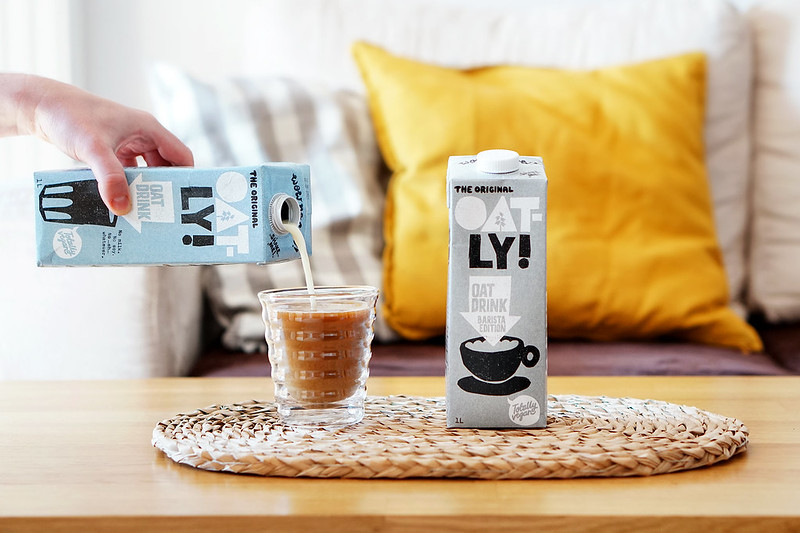Coffee with or without milk? That is the question! Some people say that coffee tastes best with no additions. Fans of the milked-based coffees, on the other hand, say that a café without cappuccino is not worthy to call itself a café. We are able to find as many followers as opponents of coffee with milk. The questions are: does milk always have to taste the same? What plant-based milks are available on the market and how do they affect the taste of coffee? Read on to get the answers.

Frothed milk mixed in an espresso cup not only looks and tastes delicious, but it also makes you feel better. Why? There actually is a scientific explanation . Milk is a mood booster. It contains tryptophan, which is an amino-acid that helps to release the calming melatonin.
Coffee with Milk – How to Choose Your Favourite Version?
In my experience, a lot of our customers enjoy coffee with milk, but they’re not entirely sure which coffee they like best. Depending on the milk / espresso ratio, the most common positions on the menu are:
Espresso macchiato: the so-called ‘stained espresso’. It contains only a dollop of milk, that is a bit of foam floating on the crema of your coffee.
Cappuccino: the Italian classic. Into the 120-180 ml cup you pour a single shot of espresso and add some frothed milk on top of it.
Latte: it has different proportions of milk and foam than a cappuccino. It is the most milky coffee in the offer, served in a 300 ml cup.
Flat white: a beverage from New Zealand. It is a double espresso filled up with warm milk with a very small amount of foam. It fits into a 180-220 ml cup.
Of course, these are not the only variations, the menus in the cafés and the versions of each milk-based coffee beverages may differ.

Which ‘Milk’ Should You Get in Your Coffee?
Coffee with milk is lighter, with a more ‘subtle’ flavour and a wonderfully foamy texture. The taste of the final beverage is, of course, affected by the taste of the product it is based on. The market keeps offering new alternatives to cow’s milk. So, which options are the best?
Let’s start with the non-vegan option: cow’s milk. It seems to be quite simple: usually cafés offer regular milk and lactose-free milks, which taste sweeter. It is important to check which specific product they use – quality is of the highest matter. In Coffeedesk cafés we use fresh milk. Despite the disadvantages of short period of consumption and the need of low temperature storage, it is the winner in terms of flavour and nutrition.
The popularity of plant-based milk alternatives is growing. There are as many reasons for choosing them as there are plant-based milks. Deciding whether you want soy, almond or oat milk may be quite a challenge. Some dairy-free options taste too intense and others do not foam well.
Soy Milk
It is probably the most common plant-based milk in the world. It is a great alternative for non-vegan products as it is high in proteins. Of course, it is lactose-free, which makes it easy to digest.
Depending on the producer and the additives, soy milk can foam great or really hard. It all depends on the experience of the brand and the barista. You need to carefully control the rotation of milk in the foaming pot to get the desired texture.
How does it taste? There are as many opinions as there are testers. Some people say that its neutral taste goes well with coffee. The opponents say that it tastes like cardboard.
Ceiran Trigg, the CEO of Ancestors Coffee in Norwich, UK, says that the nutty flavour of soy milk can complement coffee from South America but it distorts the qualities of African beans, which usually have fruity notes.
Almond Milk
Surprisingly, it has recently been much more popular than soy milk. Some consumers have chosen to switch to almond milk because they were afraid of possible interference of soy with female hormones. Still, it is not as popular in the cafés as soy or oat milk because of its taste, which is more perceptible in coffee and often stifles its sensory profile. You can feel subtle bitterness at the beginning but after a few sips you get over it and enjoy its pleasant and sweet flavour.
Its texture is lumpy, it can coagulate and split in the cup. It’s more likely to happen in the case of more acidic coffees, but it can also
result from high temperature difference between coffee and milk. In my opinion, it is one of the most challenging drinks for the barista to master.
Oat Milk

My favourite! Its original taste wins over more and more fans. It’s the most neutral of all alternative milks and does not supress the flavour of coffee. With oat milk you’re able to sense the difference among espresso from different regions. However, the brand you pick in this case is crucial. High-quality product with a proper composition of ingredients will taste completely different. In the store you can often find two milk options by the same company: regular and barista. It will not only influence the foaming of the milk, but also the taste.
Oat milks will become vegans’ favourite. They are dairy-free and lactose-free, so they are perfect for those who need to eliminate cow’s milk from their diet for health reasons.
In our cafés we use Oatly, which is created for the baristas and works perfectly for coffee. It foams well and has the correct density, so it is a good choice for latte art.

That’s Not All!
Plant-based milks from hazel nuts, cashews or hemp seeds are milk alternatives better to be avoided with specialty coffee. Hazelnuts’ characteristic taste can mask or distort the nuanced taste of the beans. Hemp milk is too watery to work with it. Coconut milk, on the other hand, is creamy and rich in composition, but it contains a lot of saturated fats, which mask coffee flavour. The same is true of rice milk.





